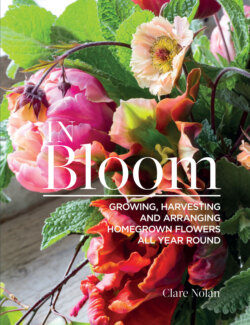Читать книгу In Bloom - Clare Nolan - Страница 19
На сайте Литреса книга снята с продажи.
A LARGE CUTTING GARDEN
ОглавлениеThe same principles apply to a large cutting garden as they do for a small patch, it’s just a question of scaling things up and adding perennials, shrubs, and trees into the mix. When you have more room to play with, it makes sense to separate the plants into growing type – planting perennial bulbs in one bed (or series of beds), your herbaceous perennials in another, annuals in another, and so on. It makes everything much easier to tend and harvest, as well as plan for.
As with the beginner’s garden on the previous page, I would suggest making the beds 47 in (120cm) deep – running east to west so that rows can be planted north to south to form blocks of plants. Make the beds as wide as you’d like, but bear in mind that if you make them too long, you won’t be bothered to walk around and you’ll end up trampling and compacting your soil.
Allow yourself a path of around 20-24 in (50-60cm) in between, with a wider path of about 39 in (1m) down the center for wheelbarrow access.
It makes sense at this point to think about a greenhouse or a series of cold frames if you have the space and the budget – at the very least consider a heated propagator and grow light to make propagating easier and quicker (not to mention more enjoyable).
A plant for cutting is only useful to you if it’s productive; once production slows down, be brutal and pull it up and replace it with something else. When planning, think in terms of space and time – how much space will a plant take up and how long will it be in the ground for? I grow seedlings in 2 ¾ in (7cm) pots or rainwater gutters elsewhere in the garden, so I have a supply of seedlings waiting in the wings to plant once one batch has gone over.
